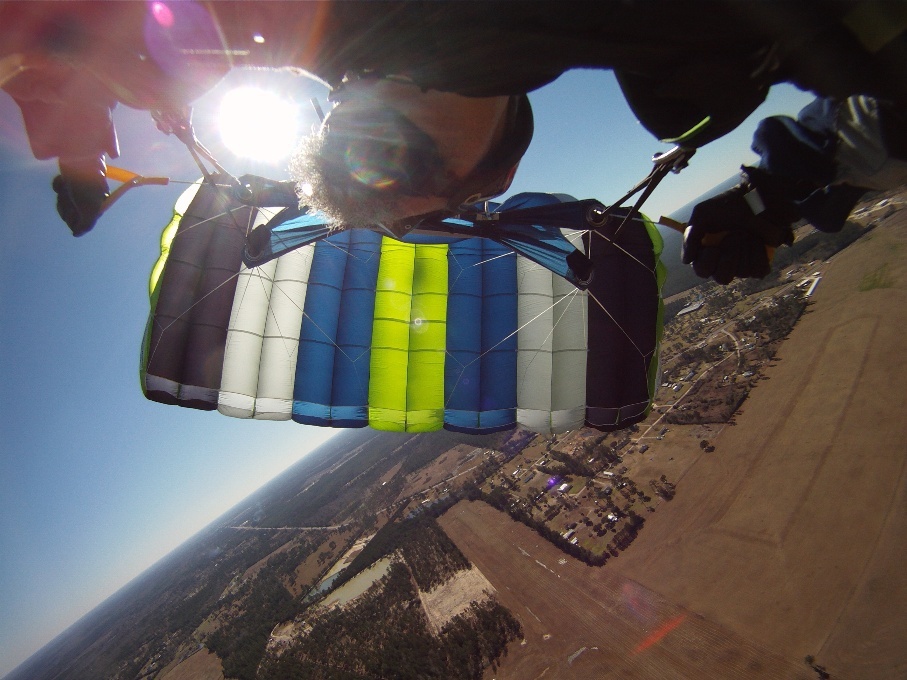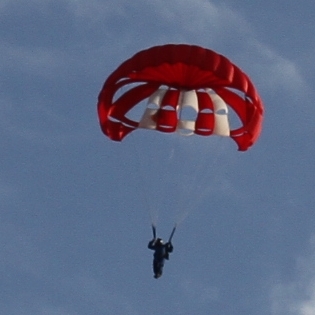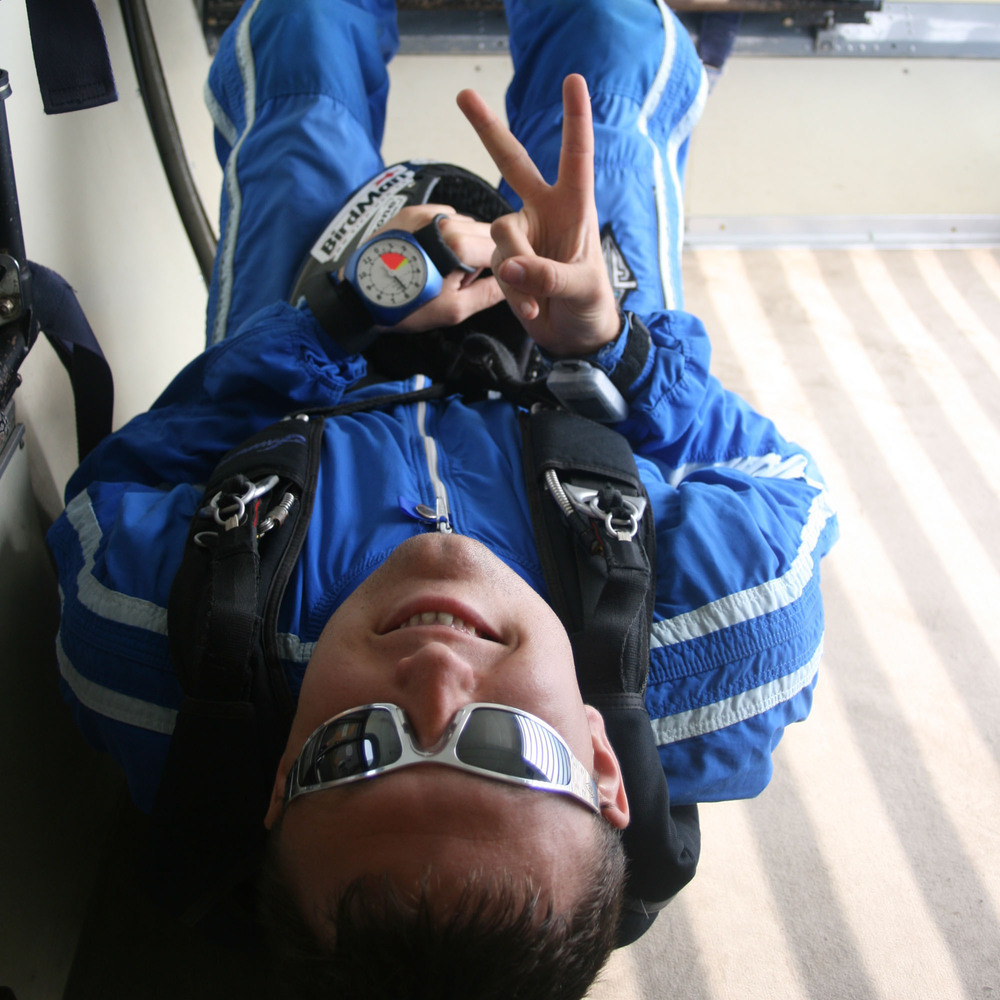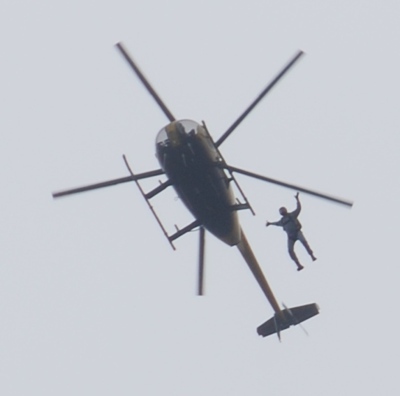Recommended Posts
RIP Matt
wolfriverjoe 1,523
But an utralight operated with a passenger doesn't fall under 103, because 103 requires a single occupant. So by default it falls under 91. And somewhere in there (not sure exactly where) 2-occupant untralight operations are restricted to "instruction purposes only." Which, kind of like tandem skydiving, allows for passengers to go up for a fun "instructional" flight.
And I don't think the FAA will go for an "instructional" flight where the student doesn't land with the aircraft.
And while "objects" can be dropped with reasoanable care (so as to not present a hazard), making an intentional parachute jump falls under part 105, which requires a TSO'd harness and reserve.
"~ya don't GET old by being weak & stupid!" - Airtwardo
(.)Y(.)
Chivalry is not dead; it only sleeps for want of work to do. - Jerome K Jerome
billvon 3,006
Agreed.
>If one is doing a jump from 1700ft with WS and intending to do a low pull, then a BASE
>rig is many times safer than a skydiving rig. This is eerie similar to TJ Bartlett going in
>in 2008.
To me that's akin to "safety should come before legality. It's way safer to jump a tiny Velocity in a BASE rig in 25mph winds than a big main and reserve in a traditional rig. You'll back up!"
Perhaps true. But saying that you are doing that "for safety's sake" is pretty funny.
JerryBaumchen 1,371
Hi joe,
I do not work for the FAA & I do not speak for the FAA.
Now, since we are all adding our $0.02 of thoughts to this:
Quote2-occupant untralight operations are restricted to "instruction purposes only."
This has always been my understanding.
Now, with this incident, my gut tells me that we just might get some new FAA rules in a few months/year or so.
JerryBaumchen
PhreeZone 20
And tomorrow is a mystery
Parachutemanuals.com
QuoteHi joe,
I do not work for the FAA & I do not speak for the FAA.
Now, since we are all adding our $0.02 of thoughts to this:Quote2-occupant untralight operations are restricted to "instruction purposes only."
This has always been my understanding.
Now, with this incident, my gut tells me that we just might get some new FAA rules in a few months/year or so.
JerryBaumchen
You beat me to it. That is my understanding also.
chuckakers 425
Quoteum .... if you go gliding (in a sailplane) ... you may only be wearing a single canopy emergency parachute .... so flying as a passenger on a Paraglider with a single canopy emergency parachute would seem to be O.K ..... If you just happen to fall out ... whoops - thankfully you're wearing a parachute ... phew
For your "falling out" theory to be legal, the rig in question would have to contain a certificated reserve packed by a rigger, sealed in accordance with FAR's, and have a data card. Additionally, the rig would need to be TSO'd as an emergency parachute system. I doubt the deceased was wearing one of those.
Nice try, though.
D-10855
Houston, TX
Ron 10
QuoteIncorrect. There is no rule regulating letting a tandem passenger on an ultralight glider (paraglider) going overboard.
Incorrect.
When you PLAN on jumping you have to meet FAR part 91 and 105.
91.307: (b) Except in an emergency, no pilot in command may allow, and no person may conduct, a parachute operation from an aircraft within the United States except in accordance with part 105 of this chapter.
105 states you need a two way radio and a notam. 105.43 states you need a main and a reserve.
http://ecfr.gpoaccess.gov/cgi/t/text/text-idx?c=ecfr&rgn=div5&view=text&node=14:2.0.1.3.17&idno=14
QuoteSo, clearly ultralight vehicles are not governed under FAR 91
There is no such thing as a two place "ultralight". Ultralight is SINGLE seat, less than 5 gallons gas, less than 254 pounds, top speed of 64MPH, max stall speed of 27.6 MPH.
Part 103: (a) Is used or intended to be used for manned operation in the air by a single occupant
Break any one of those and you now fall under part 91 and have to follow all of the FARS.
In addition, a light sport plane normally has a set of operational limitations.... Most of these operational limitations do not allow parachute operations.
There WAS an exemption that allowed two seat ultralights... That expired Jan 31, 2008. Now you need a light sport rating, or a pilots license to fly a two seat aircraft.
So light sport planes need to follow all of part 91.
To me it's rather simple here.
What, am I missing something?
Besides that, an intentional bail from an ultralight with no TSO'd reserve?
Ultralights get an exception from Part 91
Ultralight is defined as a single occupant vehicle in Part 103. On top of that, nothing you posted in Part 130 even remotely suggests that it's OK to intentionally jump one.
What type of vehicle are we discussing here?
Think on it, it'll come to you.
I've done the research. Yours is incomplete.
I think we're all Bozos on this bus.
Falcon5232, SCS8170, SCSA353, POPS9398, DS239
Ron 10
QuoteYou do not have to file a NOTAM
If you say so...... 105.25 *seems* to say otherwise.
Quote§ 105.25 Parachute operations in designated airspace.
top
(a) No person may conduct a parachute operation, and no pilot in command of an aircraft may allow a parachute operation to be conducted from that aircraft—
(1) Over or within a restricted area or prohibited area unless the controlling agency of the area concerned has authorized that parachute operation;
(2) Within or into a Class A, B, C, D airspace area without, or in violation of the requirements of, an air traffic control authorization issued under this section;
(3) Except as provided in paragraph (c) and (d) of this section, within or into Class E or G airspace area unless the air traffic control facility having jurisdiction over the airspace at the first intended exit altitude is notified of the parachute operation no earlier than 24 hours before or no later than 1 hour before the parachute operation begins.
(b) Each request for a parachute operation authorization or notification required under this section must be submitted to the air traffic control facility having jurisdiction over the airspace at the first intended exit altitude and must include the information prescribed by §105.15(a) of this part.
(c) For the purposes of paragraph (a)(3) of this section, air traffic control facilities may accept a written notification from an organization that conducts parachute operations and lists the scheduled series of parachute operations to be conducted over a stated period of time not longer than 12 calendar months. The notification must contain the information prescribed by §105.15(a) of this part, identify the responsible persons associated with that parachute operation, and be submitted at least 15 days, but not more than 30 days, before the parachute operation begins. The FAA may revoke the acceptance of the notification for any failure of the organization conducting the parachute operations to comply with its requirements.
(d) Paragraph (a)(3) of this section does not apply to a parachute operation conducted by a member of an Armed Force within a restricted area that extends upward from the surface when that area is under the control of an Armed Force.
105.15
Quote§ 105.15 Information required and notice of cancellation or postponement of a parachute operation.
top
(a) Each person requesting an authorization under §§105.21(b) and 105.25(a)(2) of this part and each person submitting a notification under §105.25(a)(3) of this part must provide the following information (on an individual or group basis):
(1) The date and time the parachute operation will begin.
(2) The radius of the drop zone around the target expressed in nautical miles.
(3) The location of the center of the drop zone in relation to—
(i) The nearest VOR facility in terms of the VOR radial on which it is located and its distance in nautical miles from the VOR facility when that facility is 30 nautical miles or less from the drop zone target; or
(ii) the nearest airport, town, or city depicted on the appropriate Coast and Geodetic Survey World Aeronautical Chart or Sectional Aeronautical Chart, when the nearest VOR facility is more than 30 nautical miles from the drop zone target.
(4) Each altitude above mean sea level at which the aircraft will be operated when parachutists or objects exist the aircraft.
(5) The duration of the intended parachute operation.
(6) The name, address, and telephone number of the person who requests the authorization or gives notice of the parachute operation.
(7) The registration number of the aircraft to be used.
(8) The name of the air traffic control facility with jurisdiction of the airspace at the first intended exit altitude to be used for the parachute operation.
(b) Each holder of a certificate of authorization issued under §§105.21(b) and 105.25(b) of this part must present that certificate for inspection upon the request of the Administrator or any Federal, State, or local official.
(c) Each person requesting an authorization under §§105.21(b) and 105.25(a)(2) of this part and each person submitting a notice under §105.25(a)(3) of this part must promptly notify the air traffic control facility having jurisdiction over the affected airspace if the proposed or scheduled parachute operation is canceled or postponed.
It shows that a notification to the controlling agency has to be made not earlier than 24 hours before and no later than 1 hour before, or you can write them no more than 30 days but at least 15 days before operations are to begin.
Now you may not call notifying the controlling agency as a notam..... But I do know that in the three years I was on a military demo team we had to file paperwork for each demo and that was referred to as a notam. Also, after you file the paperwork and as a pilot call for a briefing.... You are given the parachute operations information and the FAA guy briefing tells you about it.
ETA:
http://www.faasafety.gov/gslac/alc/libview_normal.aspx?id=7720
Under 'DropZone', 2nd paragraph, 2nd and 3rd sentence:
QuoteThe jump pilot files a NOTAM at least one hour before the first drop. Skydiving operations with continuous activity may file a permanent NOTAM.
pchapman 279
We skydivers etc can notify ATC. That isn't a NOTAM.
Only the government guys can issue a NOTAM, as a warning to aviators about some airspace issue.
It is just that if there need to be special rules for some airspace due to a demo, or an ongoing DZ, then the gov't will issue a NOTAM. For a one-off jump that needs nothing other than basic ATC coordination, no NOTAM might be issued.
Note that the Class E and G stuff doesn't even need APPROVAL, just NOTIFICATION!
ATC needs to be aware of what you are doing, but they can't stop you.
Ron 10
QuoteWe skydivers etc can notify ATC. That isn't a NOTAM.
Only the government guys can issue a NOTAM, as a warning to aviators about some airspace issue.
Semantics... We HAVE to notify them, they might (and to the best of my knowledge always do) file a NOTAM.
QuoteWhat part are you not understanding?
To me it's rather simple here.
What, am I missing something?
Besides that, an intentional bail from an ultralight with no TSO'd reserve?
Ultralights get an exception from Part 91
Ultralight is defined as a single occupant vehicle in Part 103. On top of that, nothing you posted in Part 130 even remotely suggests that it's OK to intentionally jump one.
What type of vehicle are we discussing here?
Think on it, it'll come to you.
I've done the research. Yours is incomplete.
Your post is cryptic and intriguing
QuoteQuoteWhat part are you not understanding?
To me it's rather simple here.
What, am I missing something?
Besides that, an intentional bail from an ultralight with no TSO'd reserve?
Ultralights get an exception from Part 91
Ultralight is defined as a single occupant vehicle in Part 103. On top of that, nothing you posted in Part 130 even remotely suggests that it's OK to intentionally jump one.
What type of vehicle are we discussing here?
Think on it, it'll come to you.
I've done the research. Yours is incomplete.
Your post is cryptic and intriguing
OK...more bluntly, in simple terms.
-Ultralight is defined as a single occupant vehicle
You are talking about a two seater, ergo, technically speaking, it's not an ultralight so the ultralight exception in Part 91 does not apply.
-a parachute jump from an aircraft requires a TSO'd reserve.
That's my understanding. You can safely call me stupid if you can show where I'm missing something.
(BTW, I had a typo when I wrote "Part 130".)
I think we're all Bozos on this bus.
Falcon5232, SCS8170, SCSA353, POPS9398, DS239
DBCOOPER 5
QuoteQuoteWe skydivers etc can notify ATC. That isn't a NOTAM.
Only the government guys can issue a NOTAM, as a warning to aviators about some airspace issue.
Semantics... We HAVE to notify them, they might (and to the best of my knowledge always do) file a NOTAM.
When ever your doing a real demo (one that requires form 7711-2 such as over a congested area or open air assembly of people) the certificate of authorization that comes back from the faa will typically require the filing of a notam. That is the only time you are required to file one.
If the plane is unrecoverable then exiting is a very very good idea.
As a side note, Nothing in the Federal Air Regulations is clear.






.thumb.jpg.4bb795e2eaf21b8b300039a5e1ec7f92.jpg)




the very first section of 91:
[QUOTE](a) Except as provided in paragraphs (b) and (c) of this section and §§91.701 and 91.703, this part prescribes rules governing the operation of aircraft (other than moored balloons, kites, unmanned rockets, and unmanned free balloons, which are governed by part 101 of this chapter, and ultralight vehicles operated in accordance with part 103 of this chapter) within the United States, including the waters within 3 nautical miles of the U.S. coast.[/QUOTE]
So, clearly ultralight vehicles are not governed under FAR 91 - they are governed under FAR 103. Here is applicability of FAR 103:
[QUOTE]This part prescribes rules governing the operation of ultralight vehicles in the United States. For the purposes of this part, an ultralight vehicle is a vehicle that:
(a) Is used or intended to be used for manned operation in the air by a single occupant;
(b) Is used or intended to be used for recreation or sport purposes only;
(c) Does not have any U.S. or foreign airworthiness certificate; and
(d) If unpowered, weighs less than 155 pounds; or
(e) If powered:
(1) Weighs less than 254 pounds empty weight, excluding floats and safety devices which are intended for deployment in a potentially catastrophic situation;
(2) Has a fuel capacity not exceeding 5 U.S. gallons;
(3) Is not capable of more than 55 knots calibrated airspeed at full power in level flight; and
(4) Has a power-off stall speed which does not exceed 24 knots calibrated airspeed.[/QUOTE]
Notice the above bolded section. This would seem to prohibit tandem paragliders from even being able to operate (let alone being able to drop a human off). However, the FAA has granted paragliders an exemption to be able to do tandem paragliding. Thus tandem paragliding is legal despite the applicability section of FAR 103 seeming to rule that it is not.
Now, FAR 103.9 is the last section we need to investigate to determine whether or not BASE jumping off a tandem is legal.
[/QUOTE]Sec. 103.9 — Hazardous operations.
(a) No person may operate any ultralight vehicle in a manner that creates a hazard to other persons or property.
(b) No person may allow an object to be dropped from an ultralight vehicle if such action creates a hazard to other persons or property.[/QUOTE]
So, as long as the drop is not hazardous to other people or property (say over a residential area), then it seems to be legal to drop objects (people included). There is no mention about TSO'ed gear being attached to the dropped objects. Thus, the object being dropped can be attached to a harness manufactured by a BASE gear company with a BASE canopy being used to decelerate the drop before impact.
This is my understanding after studying the FAA regulations. I write all of this because I wanted to be clear I was not seeking to lay legal blame on the individuals involved when I asked whether the gear used was BASE gear or skydiving gear. I want to be clear that I think what they were doing was legal - and that my question was intended to seek any learning points from their actions so that more of us won't go in doing this type of jump.
Share this post
Link to post
Share on other sites